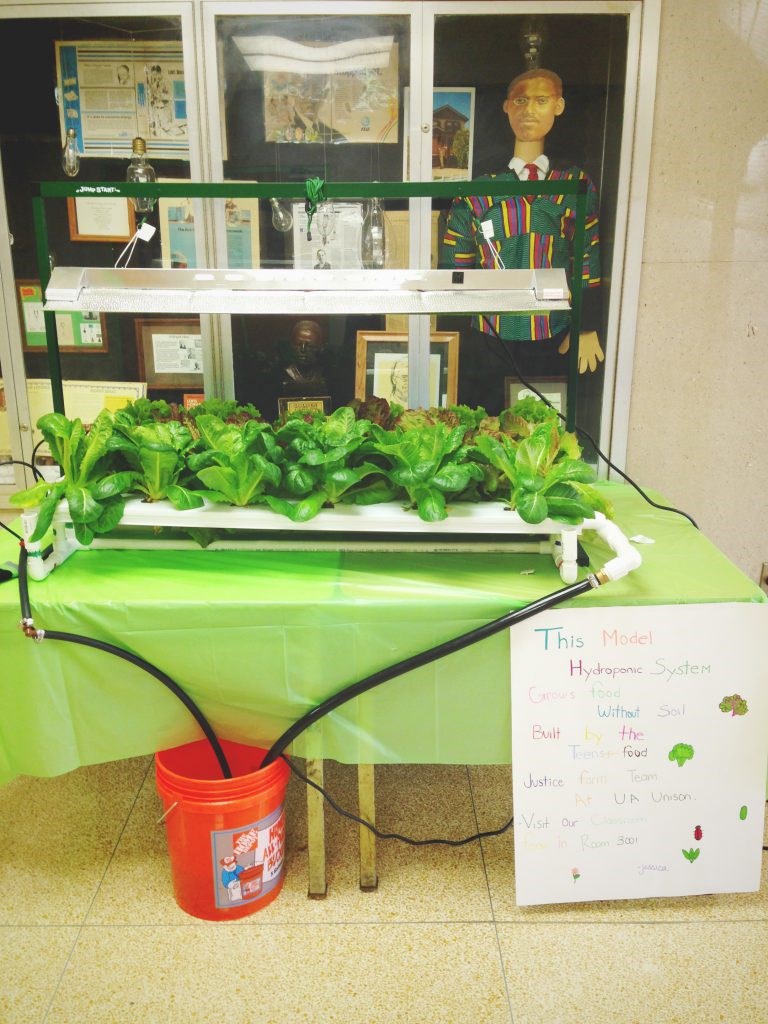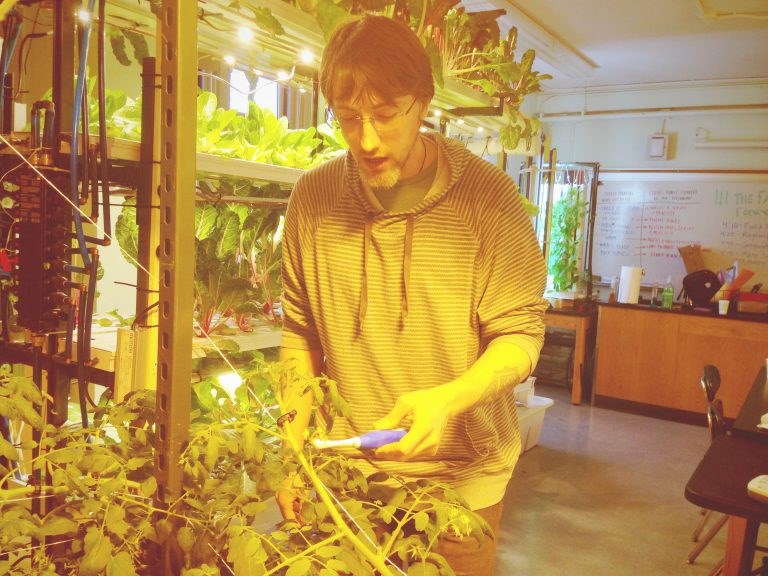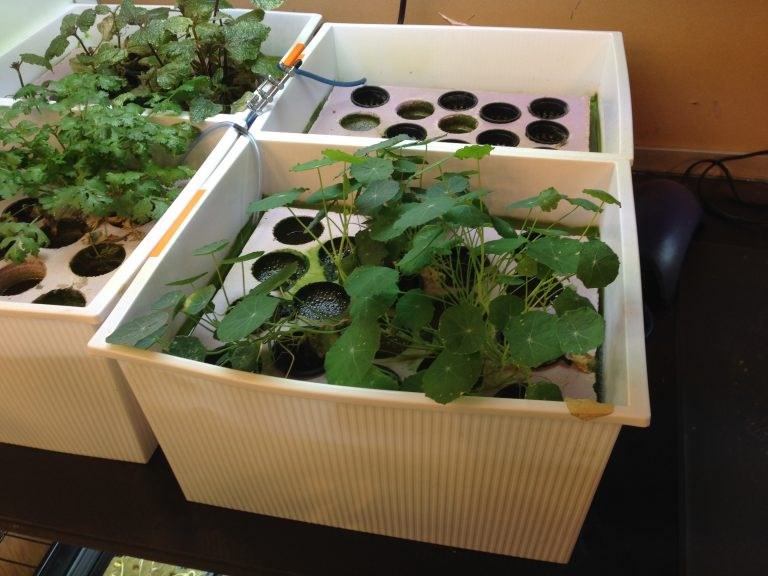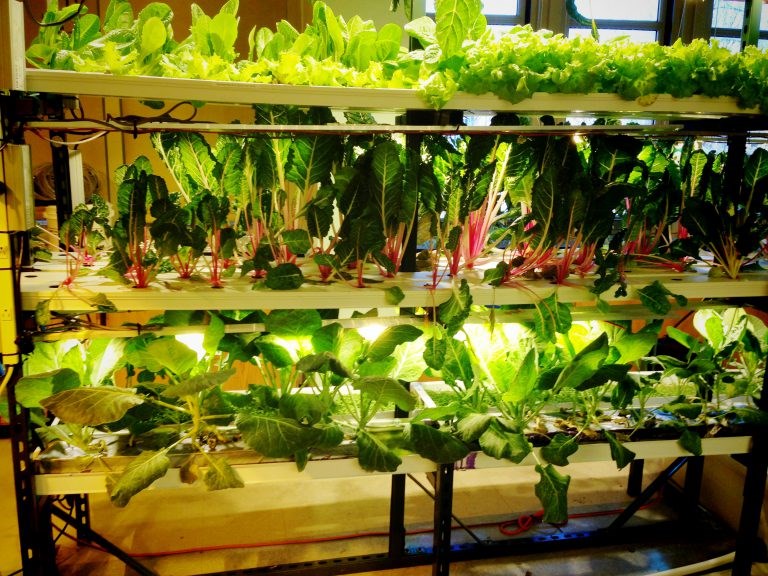
At first, I didn't notice the hydroponic unit sitting at the entrance of where visitors sign in to the Urban Assembly Unison School in Bed-Stuy.
In wasn't until later, after I had finished interviewing Mr. Harrison Hillier, the school's hydroponic system manager, that it came to my attention. Hillier was brought in by Teens for Food Justice, a non-profit organization launched in 2013 whose goal is to make affordable, healthy food to everyone.
The UA Unison School Farm was built in November 2015 inside of a science class room on the school's third floor. Back then, the school already was working with Wellness in the Schools (WITS), a Manhattan-based non-profit organization, to select healthier food for the students.
The full spectrum LED lights used to substitute sun light tinge the farm space with a golden color, resembling a scene out of a Francis Ford Coppola movie. The smell of leafy vegetables and the gentle sound of running water are sufficient for romanticizing the entire project.
[perfectpullquote align="right" cite="" link="" color="" class="" size=""]"I've heard students say to me that it gives them a sense of achievement. Sometimes we also send them home with the harvests."[/perfectpullquote]
Hillier, once a plant and soil major at University of Maryland, moved to New York City from North Carolina after he decided that breeding commercial perfectly shaped sweet potatoes was not the thing he really wanted to do: "It's almost mean to the sweet potatoes," he said.
TFFJ CEO Katherine Soll was asked to design and build the hydroponic farm, including a small aquaponic unit by the podium using fish poop as fertilizer. There are two air conditioning units in the room to lower the room temperature, helping to contain the evaporation and save water.
Hillier is responsible for the general maintenance of the facility, i.e. refilling the water container, brining in lacewings and lady bugs to eat the pests on the plants, et cetra.

Here, Hillier and two student mentors from Brooklyn College, Alyssa and Azza, grow Swiss chards, summer crisp lettuce, red peppers, toothache plants, nasturtium (a spicy plant used in salads), cherry tomatoes, among others. Pointed red pepper is the students' favorite. It's as hot as jalapeños, yet the students like to chew them.
"We look at them and they're sweating," said Hillier, laughing. "We think they're going to freak out, but after a while they want more. They think it's fun!"
Toothache plant is another student favorite: "It is a medicinal plant and makes your mouth numb," he said, plucking a leaf to give to me to chew. The harvest is also attractive.
"Maybe they like cutting the plants down, but I've heard students say to me that it gives them a sense of achievement. Sometimes we also send them home with the harvests."
Students are proud of the fact that the thing that they "built from scratch can grow food." said Soll.

The hydroponic farm's tutorial sessions don't start until 3:30pm, as a part of the afterschool activities. But while I was at there at noon, a boy poked his head inside the room but disappeared quickly when Mr. Hillier asked him for his pass.
"He is one of the enthusiasts. He always wants to hang out here," he said. "That's the reason they need a pass from the teachers to get in here. So that they don't skip their math, drama or other classes."
And who wouldn't want to skip their other classes when, in Mr. Hillier's class, you're learning cool stuff like how to manually pollinate plants, such as the tomato plants, with electric tooth brushes? Because the farm is indoors, there are no bees to do the pollination, so the kids not only learn "the birds and the bees," they actually become them!
Aside from providing students with the knowledge, the tools and the hands-on experience of hydroponic farming, the program also offers modules that introduce students to the agricultural business while educating them around food justice, that is "what goes into healthy food and the reason why some communities have plenty of access, while other have none," said Soll.

One of TFFJ's long-term goals is to inspire the student participants to make some changes toward leveling the playing field for healthy food in their own communities. Although none of the participants of the program have graduated from college yet, some them, including student mentor, Alyssa, now is pursuing earth and environmental science, as a result of her time volunteering with TFFJ during high school.
UA Unison School's hydroponic farm supplies the school's cafeteria-- and by extension, approximately 1,300 students-- with freshly grown and harvested vegetables. The program is working on expanding, to produce as much as 25,000 pounds of produce per year for student lunches. "We can do it," Hillier insisted.
In fact, everyone can do it, said Hillier. The basic material for building a hydroponic unit can be found right in Home Depot, and IKEA sells ready-made units. "You can buy one and put it in your room to grow vegetables," he said, a simple solution to the limited gardening space in New York City.
Teens for Food Justice currently is working with the office of Borough President Eric Adams to grow the program.



